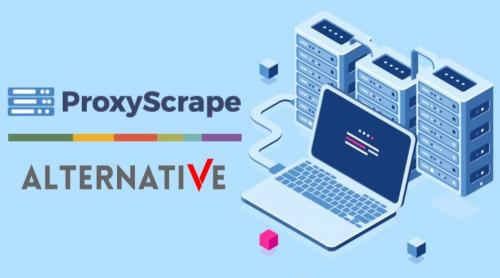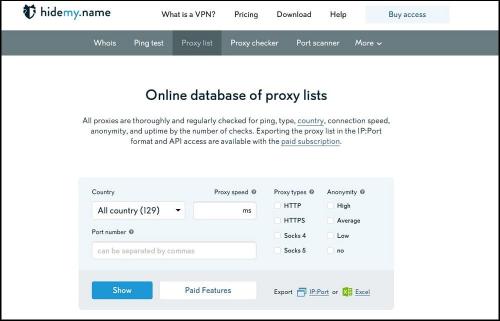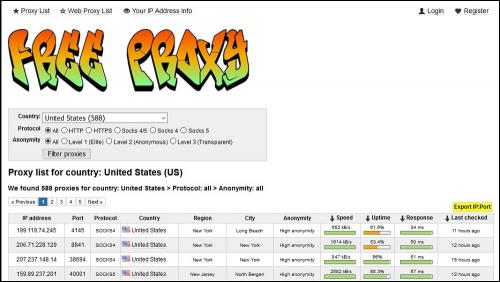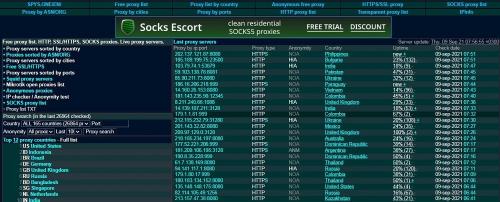10+ best proxy scraper for Free Proxies. Top ProxyScrape Alternatives for Free Proxies
10+ best proxy scraper for Free Proxies. Top ProxyScrape Alternatives for Free Proxies

Looking at the above, you can see that using ProxyScrape datacenter proxies for web scraping is a gamble that you might not want to. Fortunately for us, there are a good number of alternatives that you can make use of, and these would be discussed under the following headings – free proxy list, free proxy API, and scraping API.
Free Proxy List Alternatives
Aside from their paid proxies, ProxyScrape also offers a free proxy list for those that cannot afford to pay for their proxies. For an alternative to their free proxy list, this section has been written.
It is important I stress here that we do not encourage the use of free proxies regardless of the provider, except the free version is just for a free trial. However, if you have decided to use free proxy lists, then the below are the websites you can get them from.

The HideMyName service offers a good number of tools, including a speed test tool, a proxy checker, an email checker, and a free proxy list. Our focus is on their free proxy list. While the reliability of their free proxies, just like in the case of others, is questionable since they do not have control over it. From this website, you can get proxies of the different protocols, including HTTP(S) and Socks5 .
For the anonymity level, they have got support for high, average, low, and no. I will advise you to filter the proxy list and only make use of proxies with high anonymity, as using another one might reveal your IP footprint. In terms of location support, we can say that they have got extensive location support.

The Free-Proxy.cz website is dedicated to publishing the list of free proxy lists. It is one of the alternatives to ProxyScrape free proxies for web scraping. One thing you need to know about Free-Proxy.cz and most other websites that publish free proxy list is that they do not own the proxies they publish – the proxies are scrapped from around the Internet.
For this website, it makes money by displaying ads on its website and does not provide you any guarantee that the proxies would work. However, they carry out their own test and present the result of the tests(speed and uptime check) alongside the proxies – but at the time you will get your hand on the proxies, things must have changed.

The Spys.One website is another website you can get free proxy list alternatives to ProxyScrape. For some hobby-type scraping projects, you can try out proxies from this page. This website has support for about 165 countries. However, a good number of the locations do not have many proxies in them.
10+ Best Proxy Scrape Alternatives for Free Proxies
When it comes to web scraping, using ProxyScrape's datacenter proxies can be a gamble that you might not want to take. Fortunately, there are a number of alternatives that you can make use of, and these will be discussed under the following headings – free proxy list, free proxy API, and scraping API.
Free Proxy List Alternatives
Aside from their paid proxies, ProxyScrape also offers a free proxy list for those who cannot afford to pay for their proxies. For an alternative to their free proxy list, this section has been written.
Important Note
We do not encourage the use of free proxies, except for the free version is just for a free trial. However, if you have decided to use free proxy lists, then the below are the websites you can get them from.
Top 10 Free Proxy List Alternatives
- HideMyName - Offers a good number of tools, including a speed test tool, a proxy checker, an email checker, and a free proxy list. Our focus is on their free proxy list. While the reliability of their free proxies, just like in the case of others, is questionable since they do not have control over it. From this website, you can get proxies of different protocols, including HTTP(S) and Socks5.
- Free Proxy List - Offers a list of free proxies that you can use for your web scraping needs.
- Proxy.org - Provides a list of free proxies that you can use for your web scraping needs.
- Proxy-List.org - Offers a list of free proxies that you can use for your web scraping needs.
- ProxyList.org - Provides a list of free proxies that you can use for your web scraping needs.
- Public Proxies - Offers a list of free proxies that you can use for your web scraping needs.
- ProxyBay - Provides a list of free proxies that you can use for your web scraping needs.
- ProxyList24 - Offers a list of free proxies that you can use for your web scraping needs.
- Proxy.org.uk - Provides a list of free proxies that you can use for your web scraping needs.
- ProxyScan - Offers a list of free proxies that you can use for your web scraping needs.
- ProxySpace - Provides a list of free proxies that you can use for your web scraping needs.
Filtering the Proxies
It is important to note that the reliability of free proxies, just like in the case of others, is questionable since they do not have control over it. From this website, you can get proxies of different protocols, including HTTP(S) and Socks5. For the anonymity level, they have got support for high, average, low, and no. I will advise you to filter the proxy list and only make use of proxies with high anonymity, as using another one might reveal your IP footprint. In terms of location support, we can say that they have got extensive location support.
Free proxy list txt. Fast and stable proxies
We have proxy lists for almost every need, the list is updated every 60 minutes. We analyze Free SOCKS5 proxy list txt every minute, look for speed-appropriate IPs and add them to our database. You can see the result in the table above.FAQ
What is Canvas Fingerprinting?
Canvas fingerprinting is a tracking technique that uses the HTML5 canvas element of a web browser to generate a unique "fingerprint" for a user's device. The fingerprint is generated by rendering a hidden image or text onto the canvas element, and then collecting data about the resulting image, such as the rendering time, pixel data, or text rendering characteristics. This data is then used to create a unique identifier that can be used to track the user's device across websites.
Canvas fingerprinting is a relatively new tracking technique, and it has been criticized for being difficult for users to detect or block. It can be used for a variety of purposes, such as tracking user behavior, profiling users for targeted advertising, or bypassing cookie-based tracking methods.
There are a few ways that users can try to protect themselves from canvas fingerprinting, such as using a browser extension that blocks canvas elements, or using a privacy-focused browser that blocks canvas fingerprinting by default. However, these methods may not be completely effective, and it is important for users to be aware of the potential risks of online tracking techniques like canvas fingerprinting.
How does Canvas Fingerprinting work?
Canvas fingerprinting works by using the HTML5 canvas element of a web browser to generate a unique "fingerprint" for a user's device. The canvas element is a standard feature of modern web browsers that allows developers to draw graphics, text, or other visual elements onto a web page using JavaScript.
To generate a canvas fingerprint, a website or tracking script will typically create a hidden canvas element on the page, and then use JavaScript to render an image or text onto the canvas. The image or text may be randomly generated, or it may be a known pattern that is used to create a unique identifier for the user's device.
After the image or text has been rendered onto the canvas, the tracking script will collect data about the resulting image, such as the rendering time, pixel data, or text rendering characteristics. This data is then used to create a unique identifier that can be used to track the user's device across websites.
The fingerprint is created by combining the collected data with other information about the user's device, such as the user agent string or screen resolution. This creates a unique identifier that can be used to identify the user's device even if the user clears their cookies or uses multiple browsers or devices.
Canvas fingerprinting is a relatively new tracking technique, and it has been criticized for being difficult for users to detect or block. It can be used for a variety of purposes, such as tracking user behavior, profiling users for targeted advertising, or bypassing cookie-based tracking methods.
What Is A Data Quality Metric?
A data quality metric is a measure or set of measures that indicate the degree to which data meets a specific set of requirements or criteria. The specific criteria used for a data quality metric can vary depending on the nature of the data and the intended use case, but common criteria include accuracy, completeness, consistency, timeliness, and relevance.
For example, a data quality metric for customer data might include measures such as the percentage of missing or incorrect addresses, the percentage of duplicates, and the percentage of records that are up-to-date. By monitoring these metrics over time, organizations can assess the quality of their customer data and take action to improve it, if necessary.
Legal side: is IP tracking legal?
The legality of IP tracking varies depending on jurisdiction and the circumstances of how it is being done. Generally, the tracking of IP addresses is considered legal if it is done by law enforcement or authorized government agencies with proper jurisdiction and a court order. However, IP tracking without consent or proper authorization could be considered illegal and may violate privacy laws. In cases of cybercrime, IP tracking can be a critical tool for identifying and prosecuting the perpetrators. It is important to understand the local laws and regulations before using IP tracking technology.